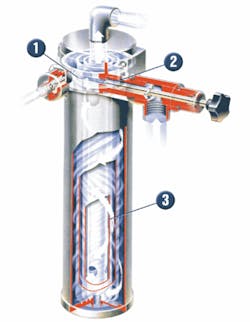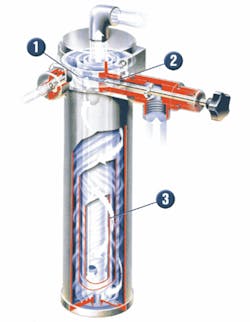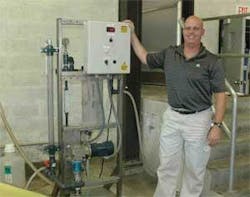New Polymer System Helps Utility Maximize Sludge Processing
By James Marengo
Last fall when Jack Robbins was surveying the operations at the wastewater treatment facility in Beatrice, NE, where he’s Superintendent of Water Pollution Control for the Board of Public Works, he didn’t really like what he saw in the sludge-processing area.
Specifically, he saw a dry-polymer make-down feed system that had been installed in 1981, one that required the mixing of dry polymer in one tank before it was transferred to another tank prior to mixing with the incoming wastewater. Through the years, this system had become a drain on the Water Pollution Control department because of its inefficient operation, the rising cost of dry polymer and safety concerns associated with handling the polymer.
Robbins knew there had to be a better way to process the sludge, both for the treatment plant and its employees, as well as the residents of Beatrice, which is located on the Big Blue River in the state’s southeastern corner. Working with Tony Bilek, a Partner in Mc2 Inc., an Omaha-based manufacturer’s representative for water and wastewater equipment, Robbins began the search for a solution.
“They had two big aging tanks, two big mixers, a day tank, two large metering pumps–it was just a big eyesore, it took up a lot of space and it was kind of dirty and cumbersome to work with,” said Bilek. “Jack asked what was out there, something more simple.”
Since the Beatrice facility’s throughput of 1.4 million gallons of water daily is considered small in the wastewater treatment business, the plant is not a huge user of dry polymer, so Bilek suggested a switch to a liquid system, namely dynaBLEND® liquid-polymer-blending technology, which was patented by Fluid Dynamics, a division of Neptune Chemical Pump Co, Lansdale. PA.
Blending polymers for sludge processing can be a tricky business as the spectrum of available polymers has grown over the years. The dynaBLEND system simplifies that process since it has been designed to effectively activate all types of liquid polymer. The system’s injection check valve has also been designed with disassembly and inspection in mind, eliminating a maintenance concern that troubles other systems.
“When I was looking over the dynaBLEND, I saw that it would eliminate the polymer mixing and we also wouldn’t need the tank for the sludge mixing either,” said Robbins. “We also wouldn’t have to make the polymer anymore. When you were mixing polymer, the heat and humidity would cause problems and occasionally you’d get spillage, which is a safety hazard.”
Convinced he had the answer to Beatrice’s needs, Robbins put the wheels in motion for an L6-P Series model and it was installed in March.
“The start-up went great,” said Bilek. “We primed the pump, got the water going and had it optimized in an hour. It’s a pretty simple system, there’s not a lot of sophistication to it, and that’s the way Jack wanted it.”
Compared to the old dry-polymer system, which required a 30-foot by 30-foot square of floor space, the new unit measures only 24 inches deep by 24 inches wide by 68 inches tall, which eliminates much of the clutter in the sludge-processing area and makes it safer for the plant’s employees.
“This is a much smaller footprint,” said Robbins. “The polymer tank we had before was six feet in diameter and four feet high and the mixing tank was six feet high and three feet in diameter–and now they’re all gone. We also had a storage bin for the dry polymer.”
Instead, the facility now has a 55-gallon drum of liquid polymer that is pumped directly into the mixer on an as-needed basis. In addition to the added efficiency, cleanliness and safety of the new system, Robbins has also noticed an economical benefit since the facility is using less of the liquid polymer.
“We’re using pretty close to half of the polymer that we used before,” he said. “We’ve gone through one 55-gallon drum in two months. We’d probably go through 400 to 500 pounds of dry polymer in the same time.”
The high-energy, non-mechanical dynaBLEND liquid-polymer activation and blending technology features HydroAction Technology, which produces in excess of six times the mixing energy per unit volume than a comparable-sized mixer.
There are three stages in the operation of the HydroAction Technology:
- Stage 1: A pressure drop across the specially designed variable-orifice water-control valve produces a high-velocity water jet. This water jet, which travels at approximately 70 feet per second, is aimed directly at, and impinges on, the polymer as it enters the mixing chamber. At this point, the only point where high energy exists in the mixing chamber, the polymer is coiled up and not susceptible to damage.
- Stage 2: In the dynaBLEND’s concentric mixing chambers, the newly blended polymer recirculates multiple times for additional exposure to non-damaging turbulence, completing the blending process. This recirculation ensures that polymer solution is present directly after the point of neat, concentrated polymer injection for an ideal activation and blending environment.
- Stage 3: The mixing energy naturally diminishes in the concentric chambers, while the flow path through the chambers further ensures optimum polymer performance by preventing polymer from short-circuiting the process.
This three-stage mode of operation ensures that the system induces high mixing energy without the use of mechanical impellers, which could cause polymer damage and gelling. Preventing polymer gelling and damage maximizes polymer investment by reducing polymer use.
About the Author:
James Marengo is the marketing manager for Fluid Dynamics, a division of Neptune Chemical Pump Co., Lansdale, PA. He may be contacted at [email protected].
Neptune® is an exhibitor at the WEFTEC.09 event and can be found at Booth No. 3530


